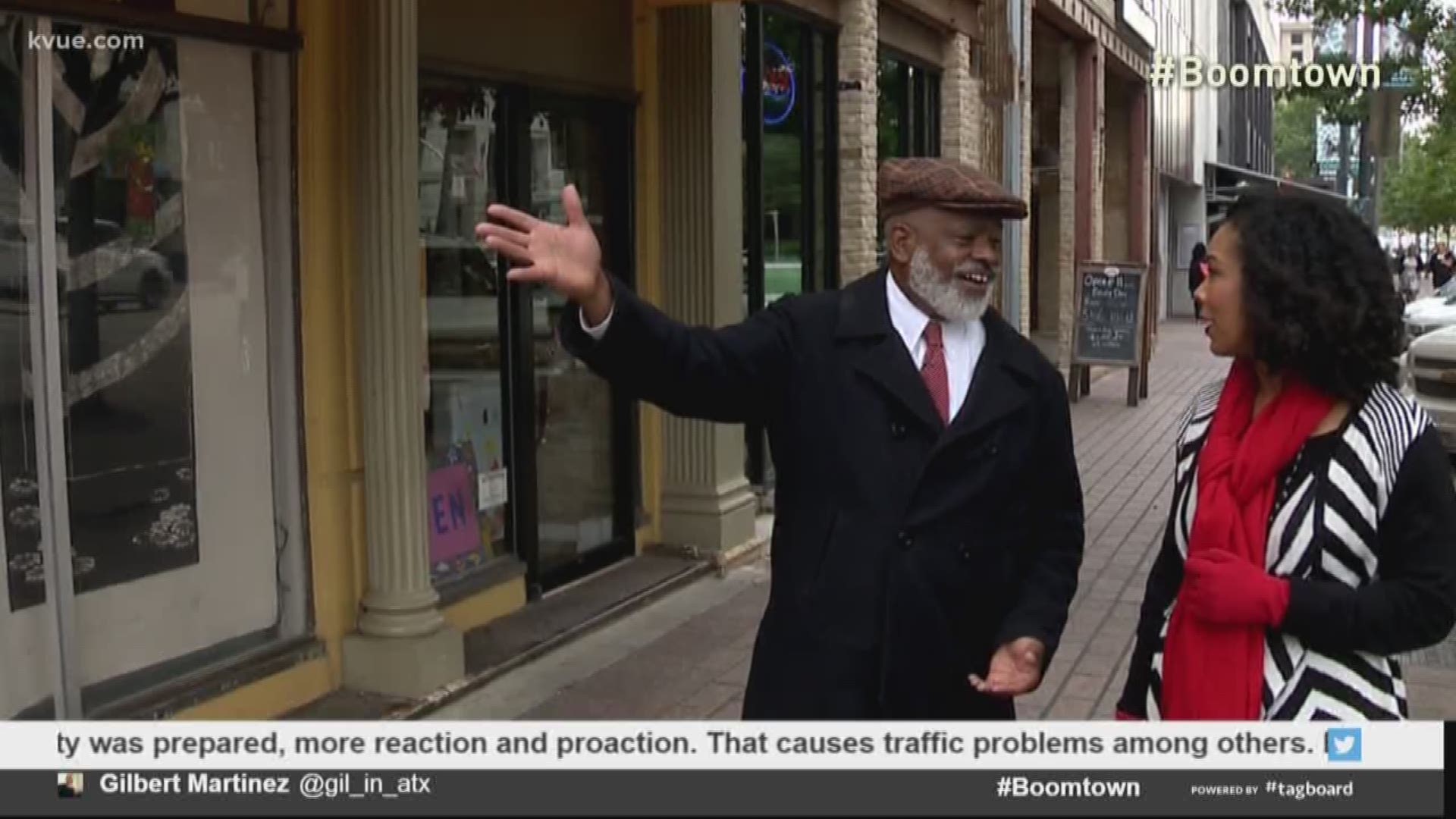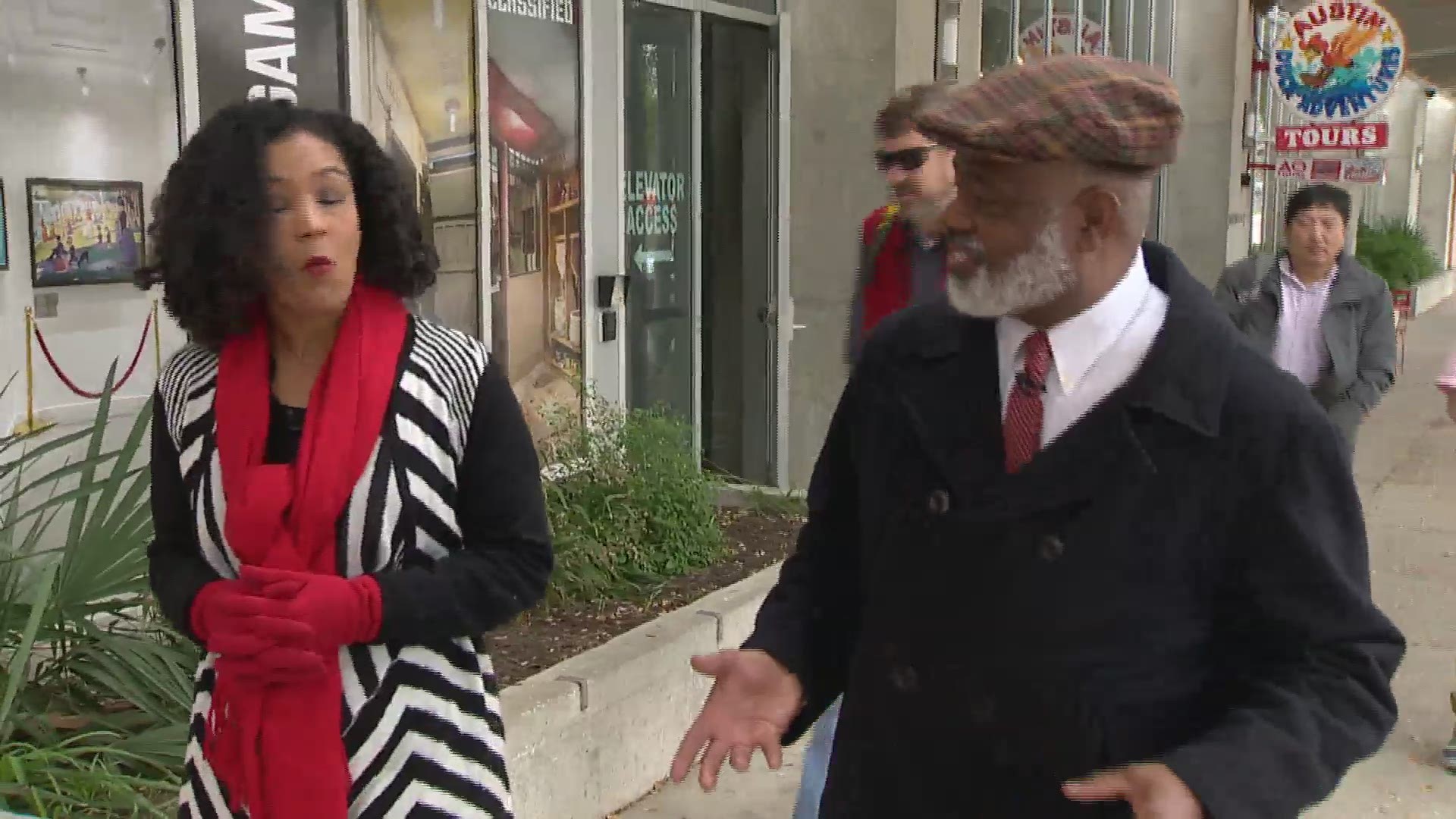As part of the KVUE Live Doc Boomtown, journalist Ashley Goudeau took a walking tour of Downtown Austin to see first hand the blend of old and new Austin.
Harrison Eppright, the Manager of Visitor Services and Tour Ambassador for Visit Austin, proved to be just the right man for the job. He's been giving tours of his hometown for ten years and has worked at Visit Austin for 24 years. He proved to be a walking history book.
Related:
Here's the facts he shared about each location:
Susanna Dickinson-Hannig House
When the city was laid out in 1839 by Edwin Waller, who laid out Austin on a European grid plan modeled after Washington, D.C., well then this was originally one of four public squares.
This house here is the Susanna Dickinson-Hannig house. Susanna Dickinson was a survivor of the Alamo.
This house was originally in another location. It was built in 1868. It was in another location. I knew it when it was a barbeque place.
She lost her first husband at the Alamo and then she married three more husbands.
You can loose sight of these little pockets of old Austin in focusing on all of the new, or being distracted by all of the new, if you will.
Austin Fire Station on 5th Street
Austin was the first city in Texas to hire black firefighters back in the 1950s. They hired three black firefighters in the early 1950s and I knew, I knew the son of Captain Louie White. I went to school with Louie White.
5th Street
I can remember as a boy when these were mostly warehouses through here.
There used to be a glass supply house on this street and I remember that my father used to go there because he worked as a painter's helper at a body shop.
People come to Austin expecting like, they think that all we have is barbeque here and country western and we have so much more to offer.
East 6th Street
East 6th Street was multicultural before multicultural was a word because East 6th Street had businesses owned by Jews, by Greeks, by Lebanese. The first Chinese-owned restaurant was started here on East 6th Street in 1898. They didn't serve Chinese food, but yeah, it was started by Joe Lung.
I try to tell people about the history of this street, because people know about the bars and restaurants at night but they don't look at the street in the daytime and look at the architecturally historic buildings on the street.
The Ritz Theater down there, which is now the Alamo Draft House at the Ritz, when I was a boy, up until 1964 the Ritz was the only theater in Downtown Austin in which blacks could patronize. We had to sit in the balcony. Our parents never told us why we went through a separate entrance after we paid to enter the theater.
That's the Jacoby-Pope building from 1874. Look at the architectural style of that building. To me, it looks kind of German. Then look at the styling of the J. W. Hannig building from 1876. Now, that was the building owned by Joesph Hannig, Susanna DIckinson's last husband, who survived her. He was 20 years younger than she. This was her happiest marriage too.
What we have on East 6th Street, we have something that we have a street that escaped the quote progress, if you will, of the 60s and 70s and 80s in which 75 percent of the buildings are still standing on this street from, let's say, they were built prior to 1900 and they're still standing.
We almost lost the Driskill Hotel. The Driskill Hotel was endangered between 1969 and 1973. That did a lot to wake people up also. They didn't pay much attention to this street. They didn't value it and they didn't pay much attention to this street.
This is a part of "Boomtown: KVUE Live Doc." Watch the full live documentary here:
This building is one of the oldest buildings on East 6th street, built about maybe 1872, 1873. It was a drug store, the Moorely Brothers Drug Company from the mid-1870s until Mr. Groove bought it out in the 1970s. O'Henry, William Sidney Porter, once worked as a druggist in this building. This building is one of the few buildings downtown to have a basement.
This is where Gellum's Department Store was, Buffalo Billiards right there. It's kind of really special for me to because my father bought me a jacket from this place back in the late 1970s. He's now passed on.
The Driskill Hotel
And most of these buildings are actually older than the Driskill Hotel, which is the Grande Dame, the Queen of East 6th Street. She is the Grand Dame because she is the Driskill Hotel. A great example of Richardsonian Roman-esq architecture. Our first truly grand hotel in the City of Austin.
It was started in 1885. That's why the date reads 1885, but it was completed and opened in 1886. And the hotel is adorned with busts of Colonel Driskill himself facing the south there, Colonel Driskill. On the east, his son Bud Driskill. And on the west side, which we can't see from this location here, you have a bust of his son Tobe Driskill.
Even with its illustrious history, the fact that it's been the site of several gubernatorial, inaugural balls, that the Johnsons, Lyndon and Lady Bird Johnso,n had suites there from 1941 until 1969. That Lyndon and Ladybird had their first date at the Driskill Hotel. They were going to tear it down because, well, business had declined and people were also going to the suburban hotels or even some of the larger hotels on the edges of Downtown Austin. People were going there and this was just considered old, it was considered out of date, out of style. And haunted, yes.
I know quite a few of those stories and even I've experienced something that was a little bit unsettling as well. Story has it that, well, if you're in the Driskill Hotel and you smell cigar smoke, well, then chances are you're in the presence of Colonel Driskill himself. I was standing at his portrait one afternoon, and just looking at his portrait and I smelled, what to me, seemed like cigar smoke. It was a little unsettling at first and then I remembered, this is what I've been telling people for years.
Also his ghost likes to play with bathroom light fixtures, story has it. I guess he's still fascinated by that new-fangled thing called electricity because when he built the hotel, when it was built for him in 1886 and opened, Austin did not have electricity at the time.
Had you been here between 1886 and 1888, you could have seen the Capitol in its final stage of construction. Now that view was altered, it was changed dramatically in 1924 when what is now the Intercontinental Stephen F. Austin Hotel, which is at East 7th and Congress, went up as our first skyscraper hotel in 1924. And then, in answer to the Stephen F. Austin Hotel going up in '24, the owners of the Driskill decided to build an annex. And so there's a sky scrapper annex attached to the Driskill Hotel to say to the Stephen F. Austin folks 'take that!' Well, then in 1938, the owners of the Stephen F. Austin added five more stories to their hotel so their hotel is taller than the Driskill Hotel and of course today, both of those hotels are dwarfed by The Aloft. They could not have seen that back then.
Congress Avenue
When Austin was first laid out in 1839, well, then the numbered streets were named for trees in Texas and then the streets running parallel to Congress Avenue, Congress was the center, the streets running parallel to Congress Avenue were named for rivers of Texas. And they still are.
The Scarbrough Building
This was the Macy's or the Marshall Fields of Austin. And at a time when every city had that signature department store that was synonymous with the city, well, Scarbroughs was that department store for Austin. And it was originally all Chicago-style architecture when it was originally built in 1909.
The Roberson Building
Those buildings there, you know, like, they pre-date, they pre-date the completion of the State Capitol building, which was first completed in 1888. The James H. Roberson building, then the Crysel building right there. You can't see the sign because of the tree. And then look at that building right over there. That became the Southwestern Telegraph and Telephone Company building. It was built in 1886, which it was a different building. They had a different business there but then in 1898 that's when the phone company moved in there. And so that you knew that the phone company was there, you had those bells carved into the front of the building.
History is not just about the past. It's about the present and it's about the future.
You know, a number of these buildings that were built in the 1970s, some people are calling that old Austin, you know. Like the Compass Bank Building, which we just passed right there. I think that's probably from the 1990s, I think. But people are calling that old Austin now.
At the end of our walking tour, Eppright shared his thoughts on Austin's future.
"You know, yeah, it's going to change. I think that it's going to change, I think, in many ways for the better. Yeah, there are going to be some things that I'm going to see lost in my lifetime. I certainly don't like the traffic situation in the city today. But you know we were complaining about the traffic, not to poo-poo it, but we were complaining about rush hour traffic when rush hour used to be only like an hour," he said laughing.
And then Eppright shared what worries him about Austin's future.
"Can I afford to live in this city? I'm 62," he said. "Can I afford to live in this city when I'm 80? You know, yeah, yeah, I worry about that. I'm certainly going to move every mountain possible to be able to stay here because, you know, I like the amenities of this city. I love the fact that we're the seat of state government, we've got so many institutions for higher learning here."
"How does that make you feel to think that this is legitimately a concern of yours that you may not be able to stay where you love," Goudeau asked.
"Well yeah, it certainly, it makes me a little anxious," Eppright replied. "Yeah, it's heartbreaking. It's heartbreaking. It's almost feeling like you're being left behind. Yeah, to me it makes me feel like I'm being left behind and here I am promoting the city."


